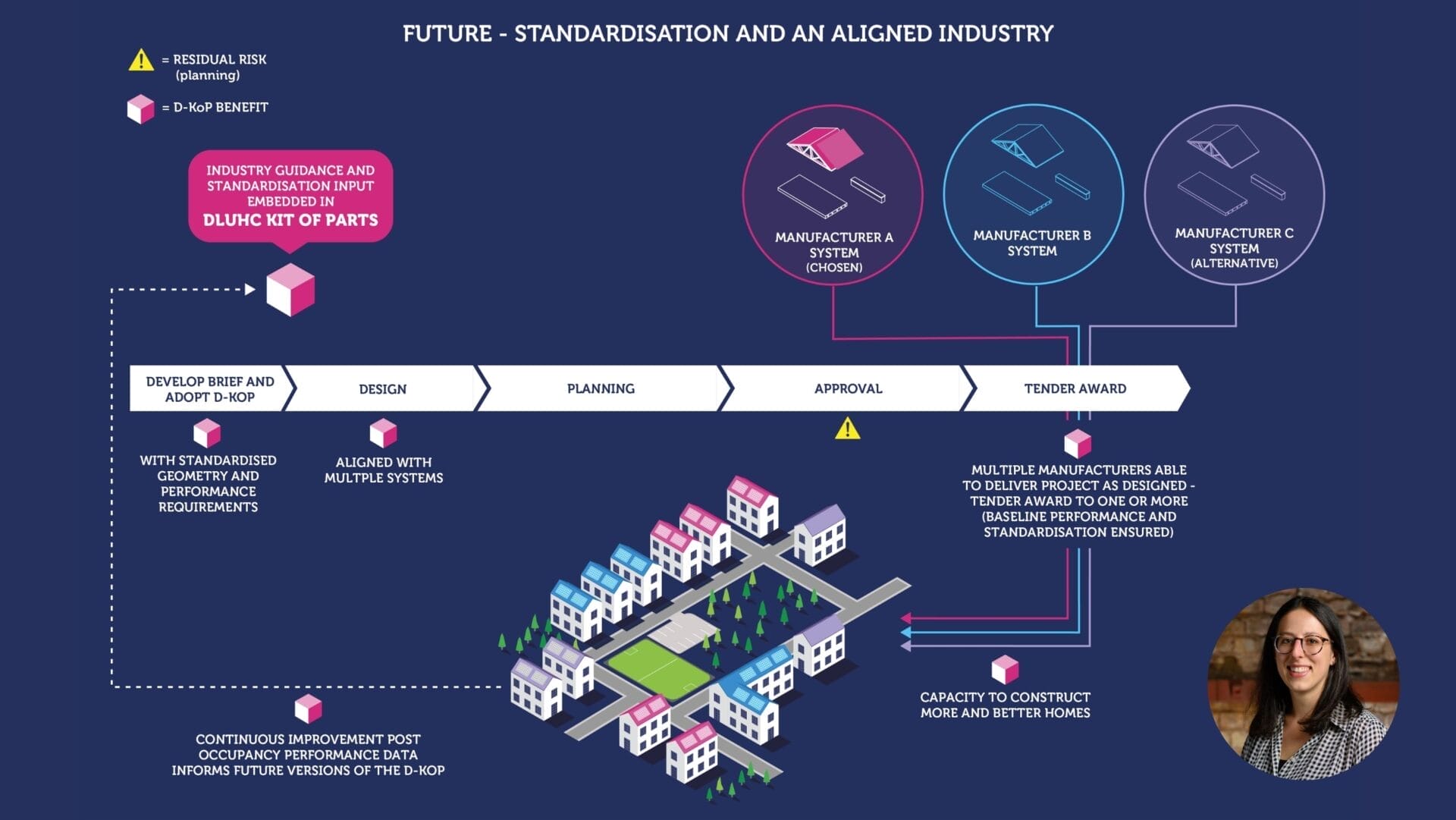
Last year a consortium led by HLM Architects Akerlof, Buro Happold and Limberger Associates were commissioned by the Ministry of Housing, Communities and Local Government (formerly DLUHC) to create an open-access Digital Kit of Parts for low rise housing using Modern Methods of Construction (MMC). This research aimed to create standardisation in the housing market and reduce barriers to MMC through use of a common digital data platform.
Market engagement and thorough analysis of compliant products in MMC Categories 2 and 5 were crucial for informing standardisation proposals and guaranteeing the success of the kit of parts by aligning it with industry needs and regulatory standards.
Standardising a Diverse Housing Sector
Standardising a sector as inherently diverse as housing is a formidable challenge. Housing encompasses a broad spectrum of products, each with unique performance characteristics and design specifications. The goal of this initiative was to create a common framework that encourages the adoption of MMC in low-rising housing, to reduce complexity, and enhance efficiency whilst preserving the essential design and performance qualities valued by users.
The approach began with extensive market engagement from myself and the HLM team involving a wide selection of over 350 participants. This in-depth consultation was crucial in developing a kit of parts that reflects the sector’s needs, supports inclusivity among multiple product providers and can begin to unlock growth within the MMC market. Contractors, designers, housing providers, manufacturers, policy makers, digital innovators, and research and strategy groups were all brought to the table.
Engagement with industry experts identified the absence of a common digital language for information exchange as a key market barrier. The industry feedback we received emphasised the value of standardising interfaces, focusing on geometry and performance requirements for a single-source structural solution. What’s more the comprehensive engagement ensured that the diverse voices within the housing sector were heard, and their needs considered, mitigating the risk of creating future issues due to standardisation.

The Technical Journey Towards Standardisation
To lay the groundwork for a digital kit of parts suitable for the housing sector, we also conducted an extensive programme of research. This research established a robust evidence base that informed the definition and contents of the kit of parts. A critical component of this research was the compilation of a database containing over 600 products, complete with detailed technical information.
With the use of interactive data visualisation software, we analysed the potential for performance and geometry standardisation across the selected products to achieve standardisation in line with the supply chain.
This analysis revealed key points of alignment, including performance and dimensional ranges, which were then incorporated into the digital kit of parts to help encourage and inform the housing market to standardise around these aspects. The digital kit of parts has the potential to provide a standardised framework that aligns with the supply chain, promoting design standardisation without compromising the unique needs of housing providers, designers, manufacturers, and homeowners. By identifying commonalities in performance and geometry, the kit helps reduce the complexity of housing construction, paving the way for increased efficiency.
The Benefits of a Standardised Approach
This specific type of standardisation presents numerous benefits for the housing sector. Firstly, it simplifies the design and construction process, reducing the time and resources required to bring housing projects to fruition. Secondly, it enhances compatibility across different products and systems, fostering greater collaboration and integration within the supply chain. Thirdly, it maintains the flexibility necessary to accommodate the diverse needs of various stakeholders, ensuring that standardisation does not come at the expense of innovation or quality.
Moreover, the digital nature of the kit allows for continuous updates and improvements, reflecting the latest advancements in technology and industry practices. This adaptability ensures that the standardisation efforts remain relevant and effective over time.
Whilst initially targeted for low-rise houses and apartments, the team ensured the kit offers potential for broader, pan-departmental applications. The impact of the open-source kit of parts extends beyond immediate construction efficiencies. It aligns with challenges in digital planning and building safety, potentially shaping future policies towards a more standardised, efficient, and environmentally conscious construction approach to a variety of sectors and applications.
A Final Thought
By embracing standardisation while respecting the sector’s inherent diversity, the Digital Kit of Parts for Low Rise Housing promises to reduce barriers to MMC, streamline the housing development process, and ultimately deliver better housing solutions for communities across the UK. The digital kit of parts is not just a tool for today, but a dynamic framework poised to evolve with the housing sector, driving efficiency, innovation, and quality for years to come.


